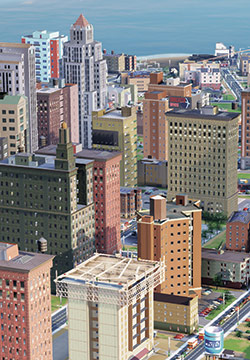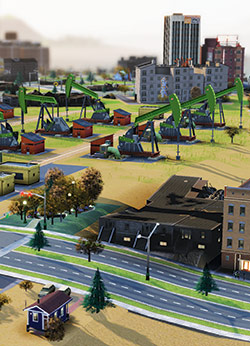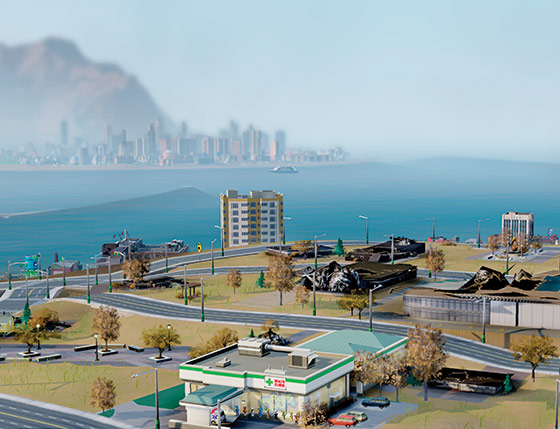
Spare a thought for Lynn Esperanza. She moved to Leoville in the early days and built a small beachfront home at the end of a quiet road. Soon, neighbors began arriving, modest people like her who asked only for basic services, jobs, and somewhere to buy groceries. Empty lots filled up, the village grew into a city, and Esperanza found work at an ice-cream factory a couple of bus stops away. She can still recapture that serenity on certain evenings, sitting on her porch, facing the sea, her back to the misery that has overtaken the once tidy town. But then the wind shifts, and noxious fumes blow across her yard, reminding her of the houses across the street that were razed even before they were complete. Leoville is reverting to emptiness, only now it’s pocked with smoldering rubble. The factory shuttered when the power failed, leaving warehouses full of melted ice cream. She’d like to leave town, but she can’t sell a property whose value, never high, has sunk to near zero.
Fortunately, Esperanza is a Sim, one of the tiny digital entities who populate the communities of SimCity, expressing their feelings in thought bubbles and occasional protests in front of City Hall, but otherwise tolerating whatever suffering their sadistic mayors inflict. The only power they wield is the ability to disappear.
SimCity is a mostly nonviolent computer game (if you don’t count the occasional giant-lizard attack), but at times it feels more savage than the usual gore-splattered fare. It allows the player—or multiple players, spread across the globe—to build communities, block by block, and then run them into the ground. Such a centralized system requires constant attention. When the player gets distracted (or wanders away for a snack), crime can spike, budgets can crumble, and unemployment can go haywire. The pursuit of prosperity is booby-trapped. The slightest misstep is enough to turn your shiny new metropolis into 1968 Newark.
Compared with the last full revision, which came out in 2003, the new SimCity offers a fantastically rich palette of urban measures. Roads snake, climb, and stretch into bridges and causeways. Pollution drifts across valleys. You can have your city specialize in electronics or mining (provided the map shows enough ore). Thanks to the game’s perpetual Internet connection, the mayor of a city adjacent to yours might be governing from a laptop in Nebraska or Tashkent. Form a relationship with that person, and you could collaborate on the construction of an “arcology,” a towering vertical metropolis on a “great works” site out in the desert.
Yet you are not God. It is the programmers who have shaped the topography, distributed natural resources, and equipped us amateur bureaucrats with all the data, maps, and charts we need to make rational, terrible decisions. It is they who demand growth but box it into tiny borders, who see no value in old buildings, who force people into their cars. Maybe the software makes it possible to cultivate an equitable, sustainable, livable city and keep it flourishing, but I haven’t achieved that level of mastery.
SimCity has existed since 1989, long enough to introduce a couple of generations to the enchantments of urban planning. When Electronic Arts released the new version, I plunged in, eager to see what a game could teach about managing a real city. My challenge was to create a passable cyber-simulacrum of New York. Instead, I discovered a strangely addictive, deeply wonky experience, producing cities where I would never want to live. Roads unfurled at my command, towers popped up, water flowed, budgets burbled, and tens of thousands of individually named and ethnically diverse Sims sped around in various states of contentment. The exercise of meaningless power is so enjoyable that at the end of a twelve-hour session, I barely stopped to wonder why I had spent so much of my weekend frantically building sewage plants.
The game is a totalitarian dream. The player-mayor single-handedly scatters parks and runs utilities. There is no Con Ed to blame for service failures, only a Department of Utilities: me. Education policy flows from functionaries lodged in a monstrous, space-consuming building that takes its marching orders from a centralized administration: me.
The wizards at Electronic Arts seem to understand cities as market-driven algorithms. Input people, rules, and resources, and the results are stability, growth, and wealth. There is some rough justification for this attitude. The physicist Geoffrey West has plowed through vast quantities of urban data from all over the globe—frequency of illnesses, miles of roadway—and shown that cities become more efficient as they grow. Moreover, efficiency increases at the same rate everywhere, suggesting that you could predict the behavior of cities with one universal equation. It’s a mechanistic worldview guaranteed to delight a programmer, but West’s theory also has a second, squishier part. Cities, he points out, are physical manifestations of human interactions. The data reveal those social dynamics, but do not necessarily shape them. From Lagos to Los Angeles to Mumbai, the physical world is experiencing a great rushing tide of urbanization, which creates huge environmental problems and at the same time concentrates the creativity needed to solve them. In the Sims’ world, though, the masses migrate and settle, then file passively through their lives. SimCity’s engineers have repeated the same mistake made by countless potentates, forgetting that cities are forged both by master builders and the people who hack their grand plans.

Real-life cities don’t develop by government decree. The largest urban agglomerations are Rube Goldberg devices held together by improvisation. Around the world, most people live in chaotically functional tangles where commerce takes the form of carts and folding tables and boiling pots of broth, where families double up and shoddy new construction abuts rickety old structures. New York was like that once and in spots still is.
I tried to create such a place. I laid down a tight web of curvy streets at the tip of an island and jumbled residential and commercial lots, hoping that houses and stores would mingle in a virtual Lower East Side. I got a few congested blocks and plenty of weedy lots too constricted for even the small house-with-a-yard that is the game’s default. SimCity has mobile homes and luxury apartment buildings, but no tenements. I soon learned to lay out a few main roads, let people move in, and, when new streets are needed, simply bulldoze the houses that get in the way.
Still, I was hoping that the newest iteration would force me to deal with the toughest challenges of contemporary urban management: sprawling, unmapped shantytowns, tracts where 100,000 people might depend on one trickling faucet and where children recycle garbage by picking over fetid mounds. I was hoping, too, for a Chinese-Korean option: the ability to erect a vacant megalopolis with one wave of the wand, complete with cloud-topping towers, subway systems, airports, and freight lines, and then let the population flow in.
And I would have liked to build some sprawl. An impassable dotted line encloses each city, and beyond that is nothing but green fields or alpine slopes. The makers may have been thinking of something like Portland, Oregon’s greenbelt—an outlying area where development is sharply limited—but in real life, sprawl picks up again on the other side. In a physical megalopolis, the dense core functions because of an encircling suburban cloud that often merges into adjacent cities. EA, though, has imagined a strange medieval South Dakota, an open landscape dotted with versions of Rapid City, linked by empty highways.
After a few false starts, I recruited a capable co-mayor, my 15-year-old son, Milo. Together we brought forth a pair of settlements, Pip City (named for our dog) and Leoville (the cat), which faced each other across a bay and engaged in beautiful regional cooperation, one of the game’s most powerful innovations. Workers commuted by ferry. A nuclear-power plant in one city kept the other juiced. Pip City grew into a pleasant, diversified city of 100,000. Milo and I tweaked tax rates to attract business yet keep revenue flowing. We worked hard to keep the smiley faces bobbing on the screen.
Being mayor, even just for fun, means getting yanked in every direction by a nonstop procession of whiners. The people want more clinics, more fire stations, less smelly neighborhoods, less polluted water, and the odd extra like Big Ben or the Eiffel Tower. These entitlement-addicted Sims have no power to make independent decisions. There are no pioneers, eager to move into some gracious, dilapidated neighborhood and fix up an old Victorian. In fact, there are no old Victorians, or old anything, really, since houses, buildings, and factories pop up in seconds and are instantly disposable. Ours is a forward-looking town, with no time for preservationist sentimentality. When a business fails or a family moves, a consultant in a hard hat appears and briskly advises us to demolish the abandoned buildings so new ones can take their place.
As Pip City grew, we worked out three guiding principles for a fine fake metropolis. The first is Money Equals Happiness. Success is measured in a fattening budget and a growing population. The wise mayor keeps an eye on the land-value map and plies the wealthy with quicker ambulance responses, bigger schools, and nicer parks. Conversely, every time we scouted suitable locations for sewage plants and garbage dumps, we wound up putting them where they would do the least damage to the economy: where land was cheap. Any Sim family who had the misfortune to live in a trailer near the power station would soon find a waste-treatment center next door, too. The game offers a candy-colored illustration of city planning at its most brutally amoral.
The second principle: Zoning Is Destiny. Developers are a compliant bunch. Merely paint a green stripe along a road, and they will start madly constructing houses. A blue commercial zone triggers burger shacks, pet stores, and dental offices. A stroke of industrial yellow lets a thousand smokestacks bloom. SimCity recognizes no amalgamation of these zones—no live/work lofts, no flat above the store, no complexes of hotels, condos, offices, and movie theaters. Instead, the game envisions a mid-twentieth-century cityscape: clustered malls, areas of box factories and concrete plants, and residential districts packed with gabled homes.

The third item in the catechism of virtual planning is Transit, Schmansit. The game has plenty of public-transportation options, but as in most of America they can easily be ignored. There is no subway, no bike paths, no separated bus lanes. We do get streetcars, a giveaway that the shining city on a hill closest to EA headquarters is San Francisco. Actual municipalities have been reducing congestion by refining tolls and parking meters; in the virtual version, on-street parking is so plentiful that parking lots and garages don’t exist. But roads rule, and woe betide the mayor who does a poor job planning them. In real-life New York, skyscrapers cluster along former cow paths, but not in SimCity: There, density requires wide boulevards, and the tallest, slickest neighborhoods in Pip City wound up looking oddly like Houston.
Leoville, too, did well at first. Draped over a picturesque promontory, it featured a ring of industrial flatlands, with a residential area perched above the smog.
Then we struck oil.
I worried: Drilling requires a lot of real estate. But Milo figured out that if we could pump oil quickly enough, the game gods would permit us to build a massive steel-and-glass Petroleum HQ, and if we extended that with a Commerce Division, we could then build a trade port, turning Leoville into a global trading center.
We might have left the oil in the ground and focused instead on creating cultural magnets. (One possibility is a very plausible avatar of the Oslo Opera House.) Instead, we issued bonds to pay for a well, then added a supplemental pump jack—then another, and another. To make room for storage tanks, we leveled factories and houses. We didn’t need to invoke eminent domain, or to battle neighbors in court. We just did it. As soon as we had accumulated the cash, we would build some new petroleum-related apparatus, which meant neglecting Leoville’s basic infrastructure needs—just for a while, we told ourselves. Some Sims began clamoring that they were “so sick we have to move out.” Fine! we said: More room for pumps! In one heartbreaking moment, we watched as a clifftop high-rise condo with a stunning view of the sea suffered an outbreak of some unspecified sewage-related disease. The tenants moved out, leaving us two bad choices: Let the handsome building fester or take it down. Renovation was not an option.
Milo looked stricken. “We’re subjugating the population to get more oil!” he said. “I feel terrible.”
Well, not that terrible: We stuck to our fossil-fueled binge, assembling an infrastructure that would shortly be obsolete. We knew we had only four months’ supply of oil, but if we could just get ourselves on a firm fiscal footing before the bounty ran out … Now the city was swimming in cash. We fixed sewage problems and added a convention center. We built a casino, which generated even more revenue—and triggered a spike in crime.
But with no land left for housing, Leoville began hemorrhaging population. Labor shortages forced industries to close. Building up cash reserves had depleted our human capital. Then the wells ran dry. We had never prepared a transition to an alternate economy, so our budget withered and our debt ballooned. The oil pumps went still. Pip City cut off the supply of nuclear power. The depleted Fire Department raced frantically around trying to put out blazes, but the rubble kept piling up. Discouraged, confused, and a little guilty, the co-mayors went to bed, letting Leoville fend for itself overnight.
By morning, our city had devolved into a hellhole. Homes rotted, and dead factories glowered. Through it all, Lynn Esperanza had remained. She was last seen trudging along a desolate sidewalk “on the way to commit a crime.” But that’s okay, really. When the treasury finally went bankrupt, a red-letter message appeared. The desperation menu offered us a few hopeless suggestions—Take Out a Bond, Raise Taxes—and one irresistible option: Build Another City.
